Jeep’s get on Track!
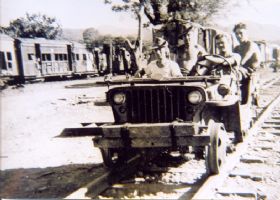
It would appear that this MB was used for shunting around rail cars, judging from the added block of wood on the front bumper.
The original idea behind the Jeep was to make a lightweight cross-country 4x4 recognisance vehicle. Who would have thought that during the war it would have it’s uses from anything from troop carrier to mine sweeper. It’s uses took on many forms, with one of them being Rail-track Jeeps.
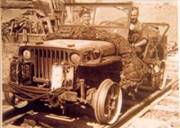
You can clearly see the extended boggy wheels on this MB.
An adaptation that came around during the war, was the use of rail Jeeps. The reason for this is more than obvious, allied bombing of German railways and trains, left railways without locomotives. So the use of railed Jeeps became an important conversion, not only in European theatres of war, but also in other areas where heavy use of railway transportation was needed around the world. Railway bogie wheels were built/designed to fit to the Jeep hubs and with the correct offset to meet the standard 4 feet 8.5 inches of standard railway gauge, although in some countries this gauge size was smaller (note the standard track of an MB/GPW was 49”). A number of conversions kits were manufactured and used in places like Normandy, Burma, Philippines, India and Java. These rail Jeeps took on a number of uses from carriage pulling Jeeps/locomotives, patrol, armoured, escort guarding to troop carrying. A large number were made to be kept as permanent rail Jeeps, although most were made so that they could be quickly converted back to road going Jeeps, and hence these types carried their original road wheels and tyres on board. A large number of field workshops also made a number of rail variations, hence there were a great number of rail variations made around the world. So the chances of finding any photos of all types of these variations today are very slim, as most were converted back to road Jeeps after the war. It has been noted that one test carried out by the US Army that a single Jeep (with its standard 2.2 litre motor), could pull a number of goods wagons weighing some 80 tons (on rails), although it did suffer greatly.
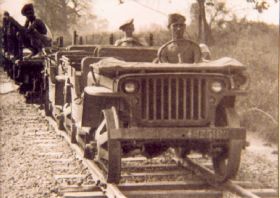
Allied troops used these two Jeep on the 37 mile railroad which ran from Mogauug Northeast to Mayitkyina in upper Burma. Both former Japanese supply bases, now in Allied hands, are close to the Ledo Road and aided in the completion of a vital supply route to blockaded China. This Jeep railroad was used to haul troops, munitions and construction equipment to posts along the front line, 4th September`44. Note two Jeeps are used to pull heavier loads, and the use of larger diameter bogie wheels!
In most cases the Jeep was adapted to stay on the lines predominately.
Although in some circumstances the design was carried out so that it could either be turned around on a track to go back from where it came from, or to be removed from the track altogether. This idea was a simple enough operation, the Jeep would drive up to the rail line, cross the line and with the use of a rotary jack placed on the centre underside of the Jeep, this would allow the troops to either change the wheels/tyres for rail bogie wheels to be added or turn it around to face the other way. To aid keeping the Jeep on its tracks/rails, the steering was braced in the straight ahead position by a bar. Which would help stop the driver from trying to steer the Jeep around bends on the track. Which must have been very interesting for the driver, as he would not know what to do with his hands!
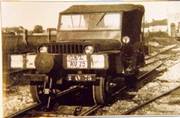
This must have been a narrow gauge track, judging from the width. Note how this one has a pertinent bumper stop and hooking device to shunt rail cars around, and one is also fitted to the rear.
This idea was also in use longer after the war had ended, as the world’s armies were still needing transportation in place of lost locomotives etc. The French army used them in Algeria and Indochina in the 1950’s, the Dutch in Java and us Brits in India etc. The following photographs will give you some ideas of what uses the Jeep had under ‘Rail-Power’ during its service days. Does this give anyone an idea for a great rebuild/show project?
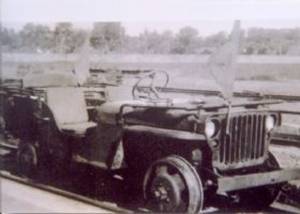
It would appear that this MB was used for transporting troops.

A very battered MB Jeep hauling armed troops and a very full supply rail car.
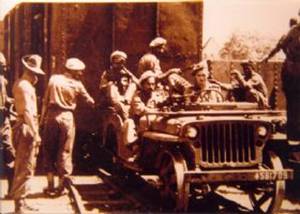
This GPW can be seen here pulling another rail car and heavily armed troops sit inside to protect the goods.